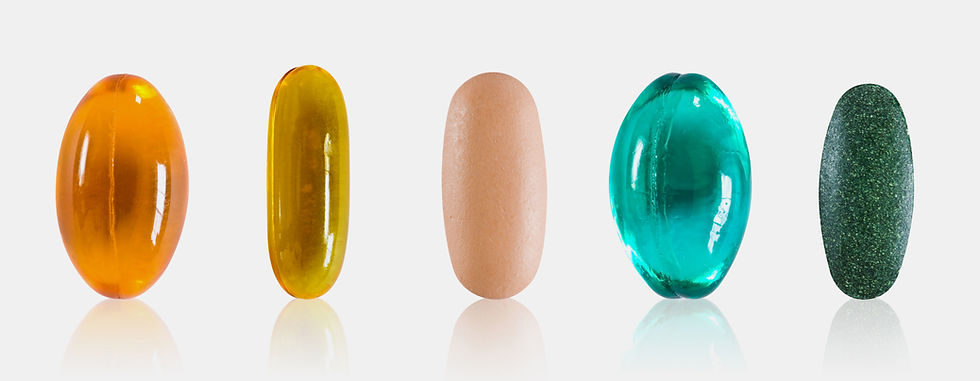What is cellulose?
- Jasmine Uchi, PharmD
- Jul 31
- 3 min read
Cellulose commonly appears on ingredient labels in products such as vitamins, foods, and

cosmetics. It’s a plant-based fiber that forms the structure of the cell walls and is a type of linked glucose unit. One of its most recognized roles is supporting digestive health as a source of dietary fiber. Its stable and adaptable nature makes it a reliable choice in health and consumer products. While it’s often dismissed as just a filler, cellulose actually serves a wide range of functions of everyday items.
Types of Cellulose
Cellulose doesn’t always appear in the same form as it does in plants. It is often modified for use in products and can serve a variety of functions. Common forms that appear on ingredient labels include:
Microcrystalline Cellulose (MCC): Often used in tablets and capsules as a binder to hold ingredients together
Hydroxypropyl Methylcellulose (HPMC): Used to make plant-based capsules and
to control how drugs are released in extended-release forms
Carboxymethylcellulose (Cellulose Gum): Works as a thickener or stabilizer in foods and personal care items
Powdered Cellulose: Added to foods to increase fiber content and improve texture
How Cellulose is Used
Cellulose’s versatility allows it to serve different purposes in various types of products. In pharmacy, it helps tablets maintain their shape, supports controlled drug release, and makes capsules easier to swallow. In the food industry, it’s often added to enhance texture, especially in products that are low in fat or high in fiber. Cellulose is also used in cosmetics to improve consistency or absorb excess oil in products such as creams and powders.
Cellulose appears in a variety of industries and product types:
Industry | Examples of Use |
Pharmaceuticals | Binders in tablets, slow-release coatings, capsule shells (Over 30,000 medications contain cellulose!) |
Food | Fiber additive in bars, anti-caking in cheese, texture enhancer in baked goods |
Supplements | Capsule material, bulking agent |
Personal care | Thickening agent in lotions, toothpaste, eye drops |
Examples of common brands using cellulose include:
Advil or Tylenol - Tablets with MCC as an inactive ingredient
Garden of Life - Plant-based protein powders and fiber blends
Nature Made - Supplements with cellulose-based capsules
Sensodyne - Toothpaste using cellulose gum for texture
HPMC vs. Gelatin Capsules: What's the Difference?
While gelatin capsules are used in over 9,500 medications and remain a widely trusted option, they may not be suitable for everyone. Gelatin is derived from animal collagen, which can pose a risk for individuals with alpha-gal syndrome (AGS) and may not align with certain dietary restrictions (such as vegetarian or vegan diets) or religious practices (such as Kosher or Halal). HPMC capsules provide a plant-based alternative that addresses many of these concerns.
Next week’s blog will take a closer look at HPMC capsules, exploring their role in health products, how they differ from gelatin, and why some patients and manufacturers choose them.
Conclusion
Cellulose is a versatile, plant-based ingredient used in everything from medications and supplements to food and personal care products. It plays an important role in stability, texture, and delivery, yet often goes unnoticed. Understanding how cellulose works can help you make smarter, more informed choices. If you're ever unsure about ingredients, the pharmacists at Pill Clarity are here to help you find answers and products that fit your needs.
Co-authored by: Tina Vuong
Disclaimer: The product and/or information provided on Pill Clarity is of a general nature and is not intended to be a substitute for professional medical advice, diagnosis, or treatment. We do not lab test the products to confirm that they are free from animal ingredients, and it is possible that the formulation and ingredients could have changed. Always seek the advice of your physician or other qualified healthcare provider with any questions you may have regarding a medical condition or product. The information provided in this post is accurate and up to date as of the date it was written. However, please note that circumstances and facts may change over time, and new information may become available that could alter the accuracy or relevance of the content. We encourage readers to verify and cross-reference any information provided here with trusted sources or consult relevant professionals for the most current and accurate updates.
Transparent medical information is a fundamental human right—your support helps keep this vital service alive.
Looking for certified and verified animal-free products?
Thank you for your awareness and concern for animal-derived ingredients!
As a reminder, please comment on our FDA Citizen Petition, requesting clear labeling of animal-derived ingredients in medications. Together, we can make a difference.
If you have any further questions about ingredients in your medicines and supplements, feel free to reach out to the Pill Clarity team!




Comments